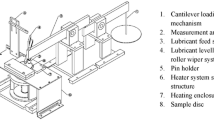Abstract
Commercial lubricants invariably contain a chemically complex additive package, one of whose roles is to produce protective boundary layers on the opposing solids: the aim of the lubricant technologist is to produce films which are physically robust enough to survive prolonged service conditions, and so prevent damaging metal to metal junctions, but slippery enough to maintain low coefficients of friction. The conventional picture of such a solid boundary lubricant layers views their shear strength as being linearly dependent on local pressure — this relation is consistent with Amonton’s laws irrespective of the geometric details of surface topography. However, the properties of adsorbed, deposited or reacted surface films, or indeed other ‘third bodies’ can be much more complex than this. In the present study we have looked quantitatively at the influence of the pressure dependence of the shear strength of a surface layer on the overall, or macroscopic, friction coefficient of a contact which is made up of an array of asperities whose heights vary in a statistical manner representative of real surfaces. The analysis results in plots of coefficient of friction versus a service or load parameter which also includes information on surface topography and the hardness of the softer surface.
Access this chapter
Tax calculation will be finalised at checkout
Purchases are for personal use only
Preview
Unable to display preview. Download preview PDF.
Similar content being viewed by others
References
Bowden, F. P. and Leben, L. (1939) The friction of lubricated metals. Philosophical Transactions of the Royal Society A239, 1–27.
Bowden, F. P. and Tabor, D. (1950) The friction and lubrication of solids. Clarendon Press, Oxford. p187.
Briscoe, B. J. and Smith, A. C. (1980) The shear properties of thin inorganic films. Reviews of the Deformation Behaviour of Materials 3(3), 151–191.
Greenwood, J. A. and Williamson, J. P. B. (1966) Contact of nominally flat surfaces. Proceedings of the Royal Society A295, 300–330
Willermet, P. A., Pieprzak, J. M., Dailey, D. P., Carter, R. O. III, Linsay, N. E., Haack, L. P. and de Vries, J. E. (1991) The composition surface layers formed in a lubricated cam/tappet contact. Journal of Tribology 113, 38–47.
Willermet, P. A., Dailey, D. P., Carter, R. O. III, Schmitz, P. J., Zhu, W., Bell, J. C. and Park, D. (1995) The composition of lubricant derived surface layers formed in a lubricated cam/tappet contact II. Effects of adding overbased detergent and dispersant to a simple ZDTP solution. Tribology International 28, 163–175
Coy, R. C., Kirsch, L. J., Bates, T. W. and Burnett, P. J. (1994) Automotive Lubrication Studies. Proceedings of International Tribology Conference Austrib 94, Perth, December 1994. pp 751–759.
Coy, R. C., Kirsch, L. J., Bates, T. W. and Burnett, P. J. (1994) Automotive Lubrication Studies. Proceedings of International Tribology Conference Austrib 94, Perth, December 1994. pp 751–759.
Samuels, B. and Richards, M. N. (1991) The transition between mild and severe wear for boundary-lubricated steels. Journal of Tribology 113, 65–72.
Author information
Authors and Affiliations
Editor information
Editors and Affiliations
Rights and permissions
Copyright information
© 1997 Springer Science+Business Media Dordrecht
About this chapter
Cite this chapter
Blencoe, K.A., Williams, J.A. (1997). Friction of Sliding Surfaces Carrying Boundary Layers: The Relation between Friction on the Micro- and Macro-Scales. In: Bhushan, B. (eds) Micro/Nanotribology and Its Applications. NATO ASI Series, vol 330. Springer, Dordrecht. https://doi.org/10.1007/978-94-011-5646-2_31
Download citation
DOI: https://doi.org/10.1007/978-94-011-5646-2_31
Publisher Name: Springer, Dordrecht
Print ISBN: 978-94-010-6381-4
Online ISBN: 978-94-011-5646-2
eBook Packages: Springer Book Archive




